I was recently asked by the good people at Proboscis to undertake a virtual residency, exploring their Bookleteer suite of tools. Bookleteer is described as “a platform for public authoring and cultures of listening—creating and sharing knowledge, stories, ideas and information”, and also as a form of samizdat for the twentieth century.
I’ll be further exploring the Bookleteer API in a future post. The code for the experiments can be found on the Bookleteer blog.
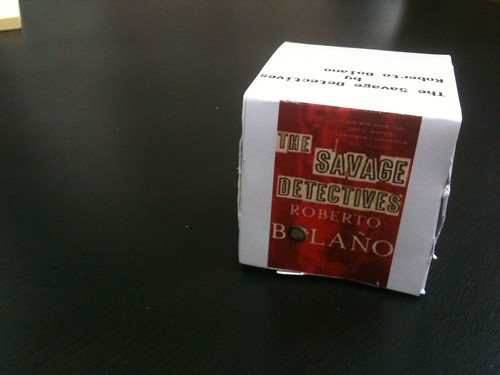
One of the subjects that came up in my thinking for SXSW, and which I mentioned briefly, was the question of souvenirs. I said then that I don’t think digital does souvenirs—I can’t think of examples of what I consider to be real souvenirs which are not discrete and tangible. And as more of our activity takes place in the realm of the virtual and the digital, there’s a growing disparity between our experience, and our records of that experience.
These records—souvenirs—are important because they serve as touchstones, aides memoires, and visual quantifiers. They remind us of where we’ve been, keep experiences in our minds, enable us to learn from them through reinforcement.
Russell Davies has written about “the way we use these little objects to say stuff about ourselves. And, in saying those things, to understand ourselves.” And in response to a brief on that topic he set last year to the Interaction Design students at the AHO Institute of Design, Svein Inge Bjørkhaug came up with a system of physical blocks that represent your activity online:
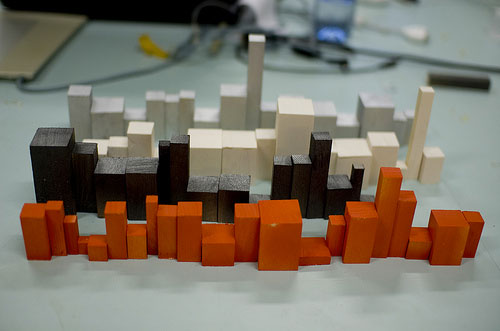 [Photo by jørngeorg on Flickr]
[Photo by jørngeorg on Flickr]
Your computer activity is monitored and every week you’re sent a little collection of these blocks. Quite soon, this becomes a very real representation of a virtual activity, and a set of objects to be reckoned with.
I was reminded of this project when thinking through my previous assertion that books are souvenirs of themselves. When people complain that they don’t want to read ebooks, I think a lot of this is due not to the reading experience itself—as everyone discovers eventually, the format disappears when you get stuck into a good story—but due to the other affordances the book offers.
Because the life of a traditional book is not just in the reading of it. It’s more like this:

And there’s a cognitive dissonance going on with ebooks, that they don’t fulfill those other cases, as well as the general problem of the tracelessness of electronic reading.
There’s another intersection here as well: the social timeline of the book—the reviews you read before you buy it and the conversations you have with your friends about it and so on. This line crosses the one above at the point of reading—which is also where Bkkeepr sits.
So it seemed natural to use Bkkeepr as the platform for experimenting with Bookleteer’s API, which allows automated access to its Diffusion eBook and Storycube generators.
For a while I’ve been meaning to add the ability to auto-generate inserts (or perhaps Moo stickers) that put your bkkeepr data back into the real world, and into your books once you’ve finished them:
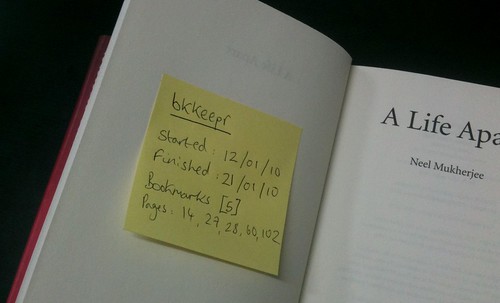
Bkkeepr is intended to eventually (cough) evolve into a scrobbling-type service not just for the books you read, but for the ebooks you read too. And it makes sense that Bkkeepr should therefore supply you with the souvenirs of this experience too:

These cubes are auto-generated from Bkkeepr data using the Bookleteer Storycube API, currently in private beta. The Storycube API takes a set of images and returns a net in pdf format (there are more pictures of the cubes and the process at Flickr):
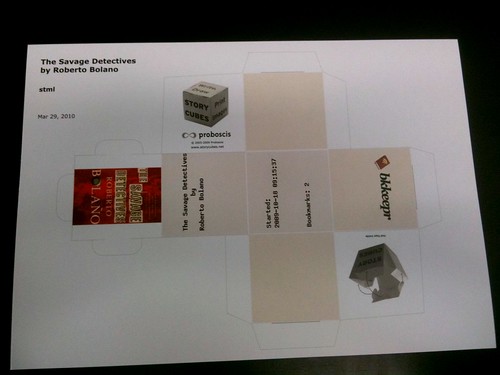
They represent a couple of months reading, and while I own physical copies of these titles, the intention is to stand for the ebooks I also consume, but which leave no physical trace on my shelves, and thus too easily slip from memory:
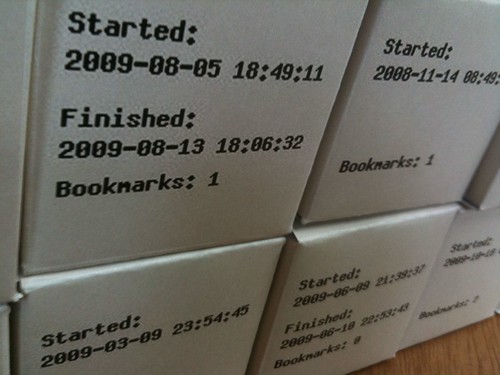

You can see how an avid ebook reader would quickly amass sets of these, which could line up along shelves vacated by the absence of physical books.
I like the bookcubes very much as physical instantiations of a virtual activity. However, as avatars for ebooks, they do strike me as a bit obvious (as well as fiddly). I think it’s probably possible to do better.
Other examples of physical souvenirs, alongside Svein Inge Bjørkhaug’s above, include the Sound Advice project, or RIG’s datadecs. These seem more abstract and less representational than getting stuck in the same book jacket trap all over again. (It still bothers me that we use book covers as the main symbol for books bought online, and even for ebooks.)
I noticed in Apple’s iBooks demo that there’s a progress bar on every page of the book:

Which is good and something I’ve argued for for a while (it’s quite prominent in Enhanced Editions) because a sense of progress is important when you’re reading a long-form piece. And perhaps this approach is applicable to a couple of other bookish problems: how do you represent the book when it doesn’t have a cover and is no longer an advert for itself, and how do you make the invisible value of a book – the time spent on it by writers and editors – visible and thus communicate that value?

Can we include metadata about the creation of the book into the book itself? (And while I’m showing and thinking with paper books and pencils here, I’m talking about ebooks.) Could the book contain the details of how long the author spent working on it, even embed its own, dated changelog?
And we’re getting into the realms of data visualisation here too, like Stefanie Posavec’s visualisations of On The Road: could we use representations not only of the text, but also of the author’s energy, to sell the book—representations which evolve further and merge with the experience of the reader to create souvenirs? Digital abstraction and re-instantiation beats tired physical nostalgia.
That is what I have been thinking about lately. Many thanks to Bookleteer for providing me with the tools to do so. I’ll be exploring their Diffusion eBooks next.
[…] used Bookleteer’s Storycube API to make physical souvenirs of ebooks, as described in my post on Bookcubes. In this post I’ll run through the code used to manipulate Bkkeepr data and send it to the […]
Pingback by James Bridle : residency part 1 — April 15, 2010 @ 10:28 am
Worst thing about iBooks? The fake pages before and after the page you’re currently looking at don’t change – you’re permanently half-way through the book.
Comment by Tom — April 15, 2010 @ 11:03 am
[…] James Bridle of booktwo plays with the idea that books – digital or otherwise – can be m…. Alright, I’ll admit it: the only reason I’m linking to this is because the Bookleteer book cubes are just so cool. Category: Linked List […]
Pingback by Linked: James Bridle on souvenirs and ‘Bookcubes’ – Novelr - Making People Read — April 15, 2010 @ 4:42 pm
[…] SEE: Bridle’s experiments with book “souvenirs” […]
Pingback by What Publishers Today Can Learn from Allen Lane: Fearlessness — April 28, 2010 @ 8:01 am
We do after al hanker after the tangible, physical object. So why…?
Comment by Kathy Page — April 29, 2010 @ 2:57 am
Love the post. Regarding the last point you made about the metadata associated with a book. I think the idea is brilliant and doable today even in physical books. Point a mobile device at the printed page and view the metadata on the device–a histogram of “effort” put forth by the author would be interesting indeed. This represents the best of both worlds in my opinion: as a reader I get the affordances of the paper book while at the same time accessing online material related to the pages I am looking at. Seems like a great way to bridge the gap between the physical, offline world and the digital, online world. And here’s an example of some early work along these lines:
http://www.youtube.com/watch?v=gwt59057-l4&feature=player_embedded
Comment by Jamey Graham — June 1, 2010 @ 6:58 am